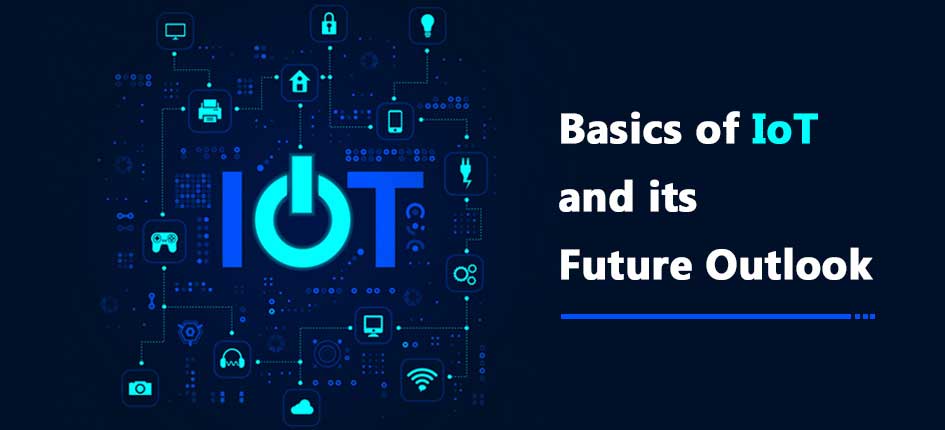Basics of IoT and its Future Outlook

Internet of Things (IoT) refers to billions of objects or devices connected via the internet for garnering and sharing information. Any physical object can be transformed into an IoT device with the help of wireless networks. Thus, senseless devices become digitally intelligent, connecting the physical world with the digital world. These smart IoT devices can communicate without human intervention and can also be controlled and monitored remotely.
Examples of IoT
As said earlier, almost every physical object can be turned into an IoT device and controlled using internet connectivity. An example of an IoT device is a light bulb that can be operated with the help of a mobile application. Similarly, a motion sensor, a smart thermostat, or a connected streetlight are some more examples of IoT devices. Moreover, only those devices can be included in IoT that are not expected to have internet connectivity, for instance, a light bulb. Thus, a smartphone and a computer can’t be considered as IoT devices.
Functioning of IoT Devices
IoT protocols are used for transferring data from one device to another through the internet. The devices’ sensors are linked to data networks like Wifi, Bluetooth, etc., and IoT platforms bridge these links. However, almost every business turn to an IoT app development company to ensure device security and prevent their data from being hacked.
Sensors/Devices
The sensors or devices garner information from the environment. This data could be as simple as a temperature reading or as complicated as a full video feed.
Sensors and devices are two different terms because many sensors can be packed together, or sensors can be a part of a device that offers much more than just sensing things. For example, a smartphone is a device that has multiple sensors like GPS, camera, accelerometer, and more. But, your smartphone isn’t just a sensor.
Whether it is a standalone sensor or device, the first step is to collect data from the environment.
Connectivity
The next step is to transfer the collected information to the cloud via a gateway. Sensors and cloud can be connected through various technologies, including Bluetooth, Wi-Fi, low-power wide-area networks, and more. Each option has tradeoffs between range, bandwidth, and power consumption, which are the major factors to choose the mode of connectivity.
Data Processing
Once the data is sent to the cloud, the software performs some kind of processing on it. This could be very easy, like checking whether the temperature is within an acceptable range. Or it could be quite complicated like using computer vision on a video to recognize objects (intruders in a home).
But what happens if there is an intruder in the home or temperature too high? This is where the user comes in.
User Interface
Next, the information is sent to the users via an alert like text, email, notification, etc. For instance, the user will receive a text when the temperature is too high in cold storage.
Also, a user might have an interface like a web browser or a mobile app through which they can proactively track their system. Using an IoT app, users may also perform an action such as remotely adjusting the temperature and affect the system.
Besides, a few actions are performed automatically. Instead of waiting for the user to change the temperature, the system does it itself through predefined rules.
Future of IoT
IoT has been a massive success since its inception due to its extensive range of applications. With the help of IoT devices, collecting, sharing, and monitoring data has become an easy task. It has been anticipated that there will about 21B IoT connected devices by the end of 2020.
The IoT applications are huge, and businesses are investing heavily in IoT Development Services to get the best app solutions. Not only this, but cities are also becoming smart by employing IoT technology and leveraging IoT connected devices. It will help in changing our environment as per our needs. There have been speculations that cities will generate a revenue of $210.2B in 2020, which was $129.8B in 2017. Similarly, other industries like transport, health, buildings, etc. will also rake in massive revenue this year.
So, to summarize, the future of the Internet of Things seems to be very promising, progressing, and bright in the long run. Also, this technology will revolutionize every industry by streamlining and expediting their operations.

